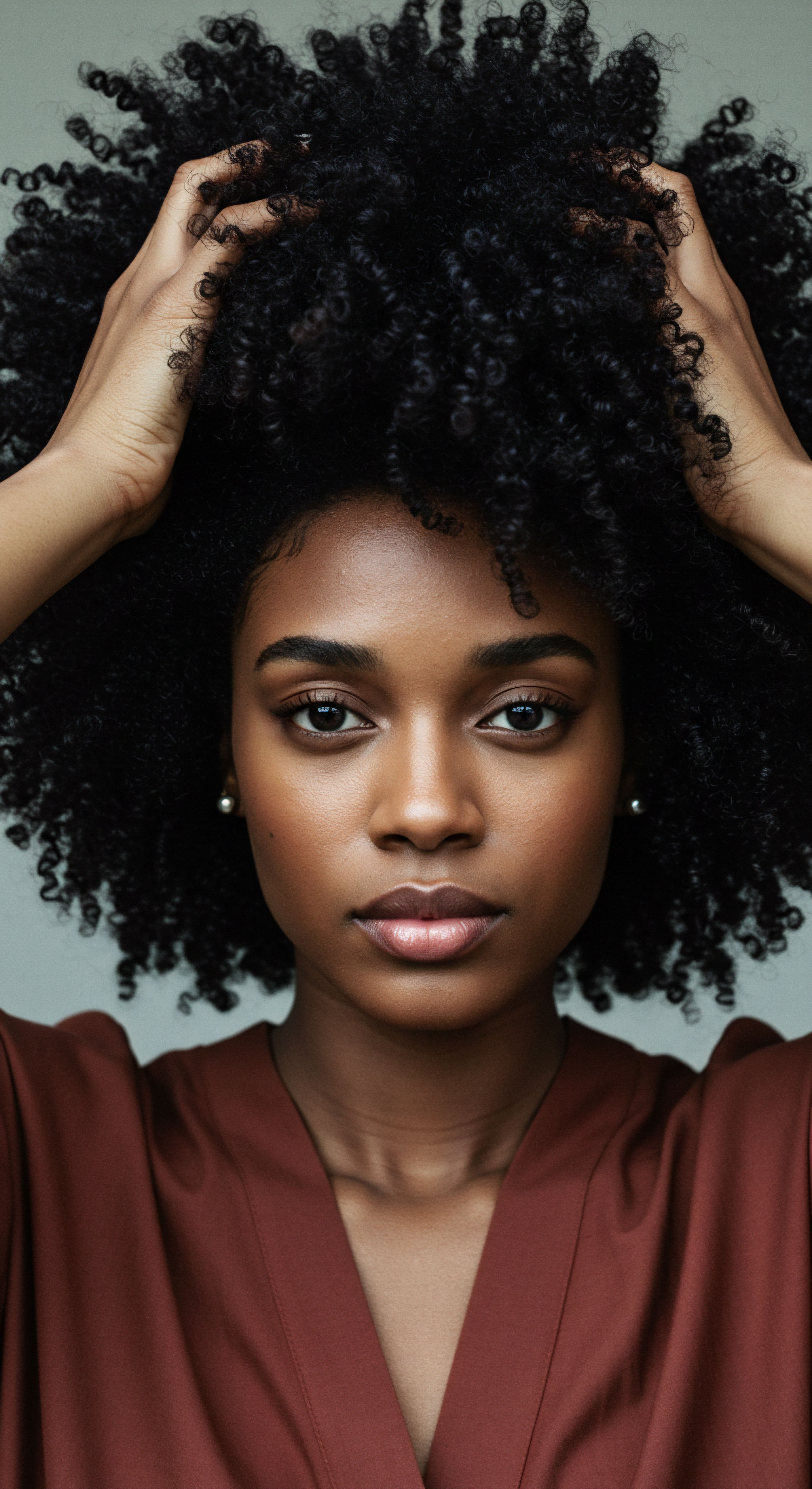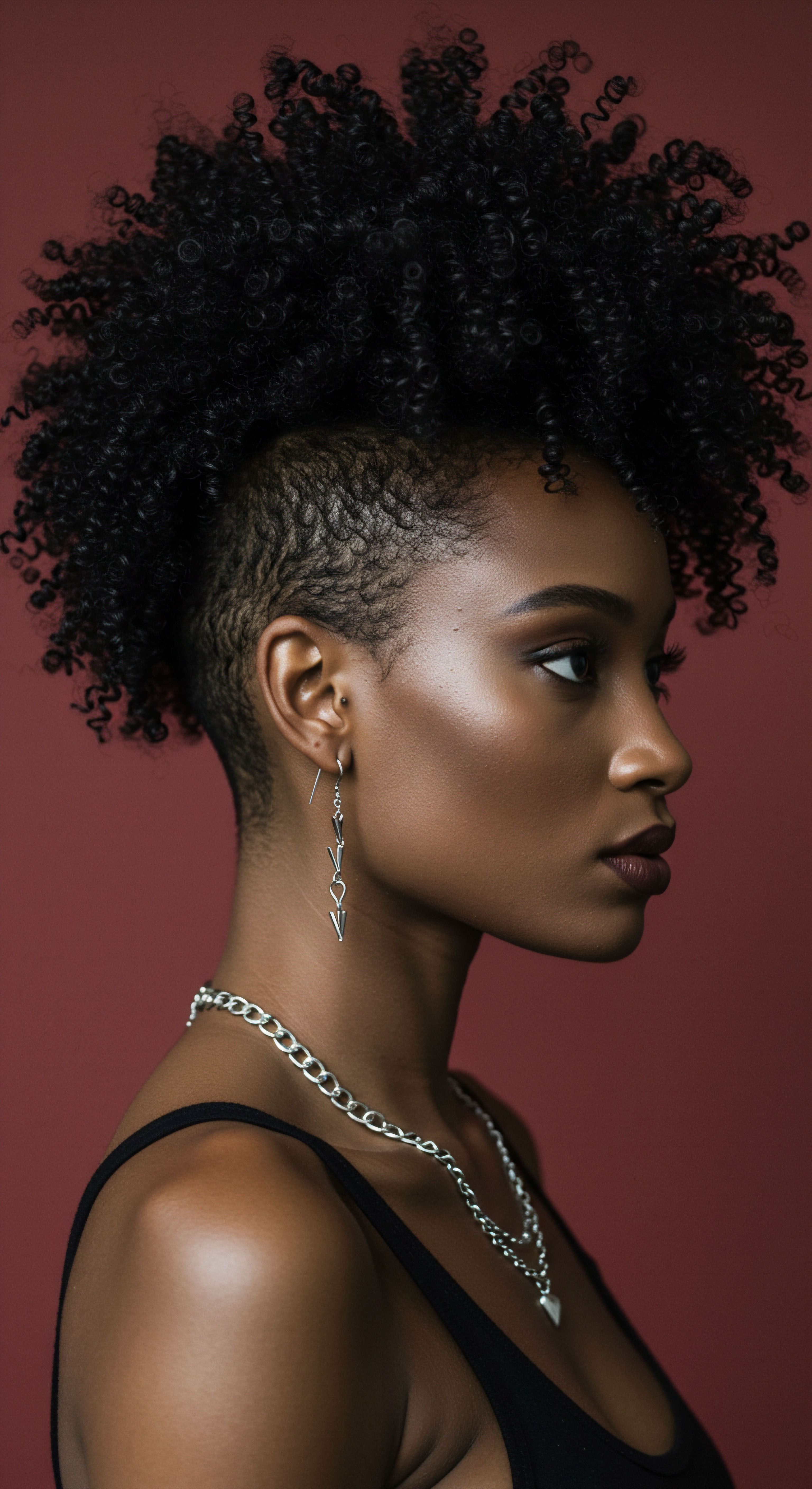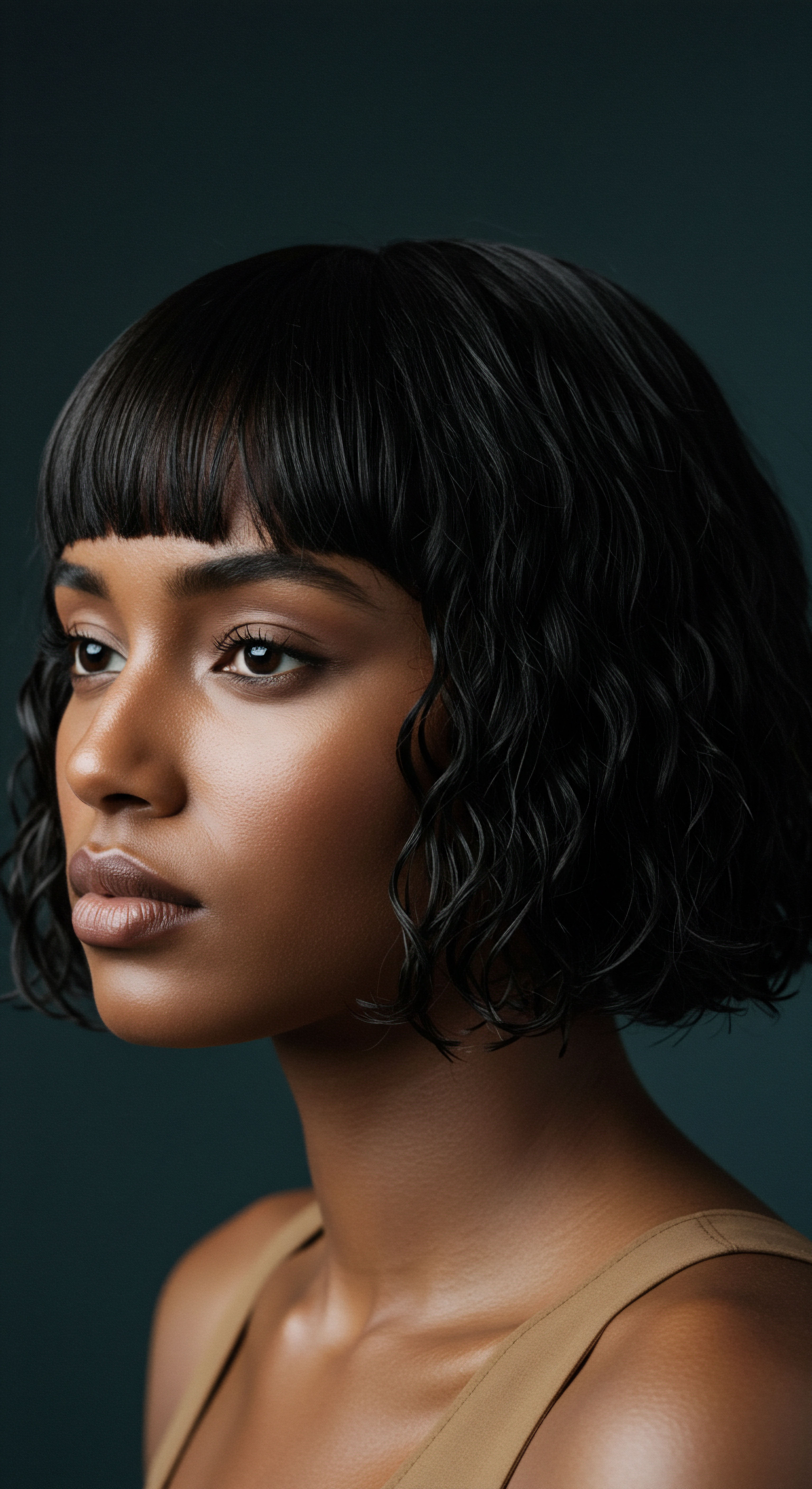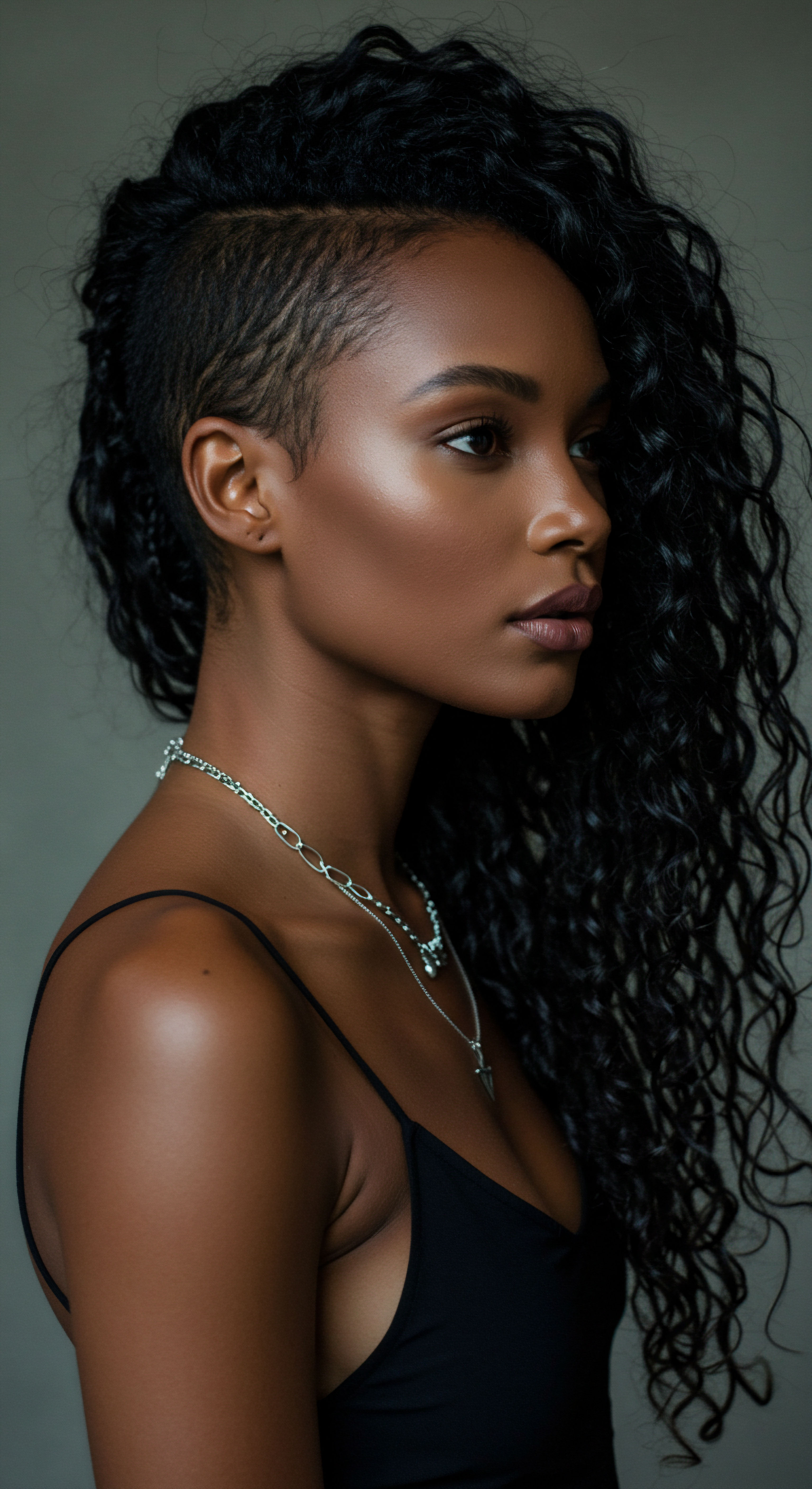
Roots
The scalp, a quiet expanse often hidden beneath our cherished strands, holds a vibrant, unseen world. It is a living landscape, a delicate ecosystem where myriad microorganisms reside in a finely tuned balance. This intricate community, known as the scalp microbiome, plays a silent yet significant role in the overall well-being of our hair and skin.
Just as the soil nurtures a garden, this microbial garden on our heads contributes to the vitality of our hair. Understanding this foundational concept is the first step in truly caring for our crowns.
For generations, practices surrounding hair care have been passed down, often rooted in cultural heritage and personal observation. These traditions, though sometimes appearing simple on the surface, often held an intuitive understanding of the scalp’s needs. The rhythms of cleansing, the selection of botanical aids, and the very frequency of these rituals were not arbitrary; they were responses to the hair’s natural state and the environment. We begin our exploration here, at the very beginnings, examining the elemental nature of the scalp and its microscopic inhabitants.

What is the Scalp Microbiome?
The scalp, a unique extension of our skin, provides a home for a diverse array of bacteria, fungi, and other tiny life forms. This collection of microorganisms, the scalp microbiome, is a complex community, with each member contributing to the overall health or imbalance of the scalp environment. The skin on our head, unlike other areas of the body, is rich in sebaceous glands and hair follicles, creating a distinct microclimate. This environment, characterized by its warmth, moisture, and lipid content, provides a fertile ground for specific types of microbes to flourish.
These resident microbes exist in a dynamic relationship with their human host. When this relationship functions in a balanced way, the microorganisms aid in protecting the scalp against unwelcome external elements and help maintain a healthy skin barrier. They can produce beneficial compounds, influencing the scalp’s pH and even impacting localized immune responses. However, when this delicate equilibrium is disturbed, certain microbial populations can grow too numerous, leading to various scalp discomforts.

How Does Cleansing Influence Scalp Ecology?
Cleansing, at its heart, is a reset button for the scalp. It is a practice designed to remove accumulated elements ❉ shed skin cells, environmental particles, product residues, and excess sebum. Sebum, the natural oil produced by our sebaceous glands, serves a protective purpose, lubricating the hair and skin. However, its presence also offers a rich food source for certain microorganisms, particularly lipophilic (fat-loving) species like Malassezia fungi and Cutibacterium bacteria.
The act of washing, therefore, directly influences the availability of these food sources and, consequently, the populations of the microbes that consume them. A gentle wash aims to remove surplus without stripping the scalp of its beneficial inhabitants or its natural protective barrier. The frequency of this ritual becomes a critical factor in shaping the microbial landscape. Too little cleansing can allow certain populations to overgrow, while overly aggressive or frequent washing with harsh agents can disturb the balanced state, potentially removing helpful microbes and altering the scalp’s protective layers.
The scalp microbiome, a hidden world of microorganisms, plays a quiet yet powerful role in the well-being of our hair.

What Are the Core Microorganisms on the Scalp?
The scalp’s microbial community is predominantly composed of a few key players. Understanding these main groups helps us grasp how cleansing practices can affect their presence and balance.
- Cutibacterium ❉ Previously known as Propionibacterium, these bacteria are often found in sebaceous, oil-rich areas like the scalp. They consume sebum, and their balance is important for scalp health.
- Staphylococcus ❉ Various species of Staphylococcus also inhabit the scalp. Some are commensal, meaning they live peacefully on the skin, while others, if overgrown, can be associated with scalp concerns.
- Malassezia ❉ This genus of yeast is a natural resident of the scalp, particularly in areas with active sebaceous glands. While typically harmless, an overabundance of Malassezia species, such as Malassezia restricta and Malassezia globosa, is frequently linked to dandruff and seborrheic dermatitis.
These microorganisms are not static; their populations fluctuate based on various intrinsic and extrinsic factors, with cleansing frequency standing as a significant extrinsic influence.
| Microorganism Type Bacteria |
| Common Species Cutibacterium acnes |
| Typical Role on Scalp Consumes sebum, contributes to skin pH. |
| Microorganism Type Bacteria |
| Common Species Staphylococcus epidermidis |
| Typical Role on Scalp Commensal, can inhibit harmful bacteria. |
| Microorganism Type Yeast (Fungi) |
| Common Species Malassezia restricta, Malassezia globosa |
| Typical Role on Scalp Lipophilic, associated with dandruff in excess. |
| Microorganism Type Maintaining a balanced presence of these microbes is key for a serene scalp. |

Ritual
Stepping beyond the elemental, we turn our gaze to the rhythms we establish in our daily lives – the cleansing rituals that shape our hair’s existence. For those with textured hair, this practice carries a unique weight, often influenced by the hair’s inherent structure and the time required for its care. The question of how often to cleanse is not merely a matter of hygiene; it is a conversation with our scalp’s living, breathing community. It is here, in the space of deliberate action, that our understanding of cleansing frequency and its impact on the scalp’s microbial landscape deepens.
Many individuals with textured hair find themselves navigating a delicate balance. The unique coil patterns can make it more challenging for natural oils to travel down the hair shaft, leading to a perception of dryness in the strands, even if the scalp produces sebum. This characteristic often leads to longer intervals between washes, a practice born of a desire to preserve moisture and avoid over-stripping. Yet, this choice carries its own set of considerations for the scalp’s microscopic residents.

How Does Cleansing Frequency Affect Sebum Accumulation?
Sebum, the scalp’s natural conditioning agent, plays a dual role. It offers protective lubrication to the hair and skin, but it also serves as a nutrient source for various microorganisms. When cleansing frequency is lower, sebum accumulates for longer periods on the scalp surface.
This extended residence time allows for greater chemical alteration of the sebum, including the formation of free fatty acids and oxidized lipids. These altered compounds can be irritating to the scalp skin.
For textured hair, where wash days can be extensive and involve multiple steps, the inclination to extend the time between cleanses is understandable. However, this extended interval means that the scalp’s sebaceous environment remains undisturbed for longer, potentially creating a more hospitable setting for certain microbial populations to multiply, particularly those that thrive on lipids.
The rhythm of cleansing, whether frequent or spaced, directly influences the scalp’s sebaceous environment and, by extension, its microbial residents.

What Happens to Scalp Microbes with Infrequent Cleansing?
Infrequent cleansing can lead to a shift in the scalp’s microbial composition. When sebum and shed skin cells build up, they create an environment that favors the growth of lipophilic microorganisms, especially certain species of Malassezia yeast. An overgrowth of Malassezia is a widely recognized contributor to dandruff and seborrheic dermatitis, conditions characterized by flaking, itching, and sometimes inflammation.
Consider a study where individuals were monitored for changes in scalp microbe content during periods of low wash frequency. Researchers observed a significant increase in scalp Malassezia levels, accompanied by a rise in scalp itch and flaking. This highlights a direct correlation between less frequent cleansing and the proliferation of microbes associated with common scalp discomforts. For textured hair, which often naturally retains more heat and moisture at the scalp due to its density, this environment can become even more pronounced, potentially accelerating microbial shifts if cleansing is not approached mindfully.

Does Daily Washing Cause Over-Stripping for All Hair Types?
The concern about “over-stripping” the scalp with frequent washing is a common one, particularly within the textured hair community. The perception is that daily cleansing removes essential natural oils, leading to dryness and potential damage. While harsh shampoos can indeed strip the scalp and hair, the reality is more nuanced.
Modern, well-formulated shampoos are often designed to cleanse effectively without causing undue dryness or disrupting the scalp’s natural pH. Research indicates that for some populations, higher wash frequency can actually lead to improved scalp and hair conditions. A study involving Asian populations, for instance, concluded that washing 5-6 times per week led to the highest overall satisfaction with hair and scalp conditions, with no objective detrimental effects observed on hair quality.
This suggests that the impact of cleansing frequency is highly dependent on the products used and individual scalp characteristics. For textured hair, selecting gentle, sulfate-free cleansers that preserve moisture is paramount, allowing for more frequent cleansing if needed without the fear of stripping.
| Cleansing Frequency Less Frequent (e.g. bi-weekly) |
| Potential Scalp Impact Increased sebum buildup, potential for irritation. |
| Common Microbes Affected Malassezia (overgrowth), specific bacteria. |
| Cleansing Frequency More Frequent (e.g. 2-3 times weekly) |
| Potential Scalp Impact Reduced sebum accumulation, fresher scalp. |
| Common Microbes Affected Helps manage Malassezia populations. |
| Cleansing Frequency Daily (with gentle products) |
| Potential Scalp Impact Maintains consistent cleanliness, minimizes irritants. |
| Common Microbes Affected Supports balanced microbial environment. |
| Cleansing Frequency The ideal frequency is a personal discovery, guided by individual scalp needs and product choices. |

Relay
Having considered the elemental foundations and the rituals we adopt, we now delve into the deeper currents that connect cleansing frequency to the complex world of scalp microbial diversity. This exploration takes us beyond the surface, into the subtle interplay of genetics, environment, and the unique physiological characteristics of textured hair. The conversation surrounding cleansing frequency for textured hair often carries echoes of historical practices and ingrained perceptions, sometimes overlooking the scientific nuances of the scalp’s living terrain.
The human skin microbiome, including that of the scalp, is influenced by a myriad of factors, both intrinsic and extrinsic. Ethnicity, gender, age, and even geographical location play a part in shaping these microscopic communities. For textured hair, which often originates from diverse ancestral backgrounds, these underlying influences become particularly relevant. Our aim here is to peel back the layers, revealing how these intricate factors contribute to the scalp’s microbial response to cleansing practices, and to challenge conventional wisdom with scientific inquiry.

What are the Unique Microbiome Considerations for Textured Hair?
Textured hair, with its distinct curl patterns and varying densities, creates a unique microenvironment on the scalp. The spiral shape of the hair shaft can impede the even distribution of natural sebum along the strands, often leading to a perception of dryness in the hair itself, even if the scalp is producing oil. This characteristic can influence cleansing habits, as individuals may opt for less frequent washing to avoid exacerbating perceived dryness.
However, a consequence of less frequent washing can be the accumulation of sebum and shed skin cells on the scalp, potentially creating a more hospitable environment for certain microorganisms. Research indicates that differences in scalp characteristics and hygiene habits exist across various ethnic groups. For instance, a study noted that the average number of shampoos per week was considerably lower in African American individuals (1.9 times per week) compared to Caucasian American individuals (4.7 times per week). This difference in cleansing frequency can lead to distinct microbial profiles.
Textured hair’s unique structure and associated care practices sculpt a distinct scalp environment, influencing its microbial residents in profound ways.

Does Low Wash Frequency Impact Scalp Health in Textured Hair?
The question of whether lower wash frequency, often associated with textured hair care, negatively impacts scalp health is a subject of ongoing investigation. While general recommendations for hair washing frequency often vary, studies focusing on specific populations offer compelling insights.
Consider a study conducted in Durban, South Africa, involving 60 women of African descent aged 20–40 years. This research observed that dandruff severity, a common scalp concern, peaked at the end of the first week after hair washing and then plateaued. Furthermore, the study revealed a clear association between higher colonization of Malassezia species and bacteria with dandruff, regardless of the specific time point. Crucially, the researchers concluded that the benefits of a single wash were not sustained beyond one week, leading them to recommend weekly hair washing for the long-term management of dandruff and scalp itchiness within this population.
This finding suggests that for some individuals with textured hair, a more consistent cleansing schedule might be beneficial in maintaining a balanced scalp microbiome and alleviating discomfort, challenging the blanket assumption that less frequent washing is always superior. The study underscores the idea that a scalp prone to conditions like dandruff may require regular removal of microbial food sources and irritants to prevent symptom escalation.

How Do Products Influence Scalp Microbial Balance?
Beyond cleansing frequency, the very products we choose play a substantial role in shaping the scalp’s microbial landscape. The ingredients within shampoos, conditioners, and styling products can either support or disrupt the delicate balance of microorganisms. For instance, harsh surfactants, such as sodium lauryl sulfate (SLS), are known to significantly alter microbial diversity and reduce the relative abundance of beneficial species on the skin. These ingredients can also compromise the skin barrier function, making the scalp more vulnerable.
Conversely, products formulated with gentle cleansers and beneficial ingredients can help maintain a healthy scalp environment. Components like prebiotics, which nourish beneficial bacteria, or specific amino acid derivatives, which can help regulate sebum without stripping, contribute to a more balanced microbiome. For textured hair, which often relies on a variety of styling products, understanding the cumulative effect of these formulations on the scalp is paramount. Regular, gentle cleansing helps remove product buildup that could otherwise provide additional food sources for unwanted microbial growth, allowing the scalp to breathe and its natural balance to restore itself.
| Factor Category Intrinsic Factors |
| Specific Influences Genetics, Age, Sex, Ethnicity |
| Impact on Microbiome Shapes baseline microbial composition. |
| Factor Category Extrinsic Factors |
| Specific Influences Cleansing Frequency, Product Ingredients |
| Impact on Microbiome Directly alters microbial populations and environment. |
| Factor Category Environmental Factors |
| Specific Influences Pollution, Climate, Humidity |
| Impact on Microbiome Can introduce new microbes or stress existing ones. |
| Factor Category A holistic approach considers all elements influencing scalp microbial harmony. |

Reflection
Our journey through the scalp’s hidden world reveals a profound truth ❉ the care we offer our hair extends far beyond surface beauty. It is a dialogue with a living ecosystem, a dance between our routines and the microscopic life that thrives beneath our strands. The question of cleansing frequency, particularly for textured hair, ceases to be a simple dictate and transforms into an invitation for mindful observation.
It asks us to listen to our own scalp’s unique rhythm, to discern its whispers of comfort or disquiet, and to select practices that truly nourish its delicate balance. There is no single answer, only a continuous process of understanding, gentle adjustment, and honoring the vibrant life that supports our crown.

References
- Skin Microbiome. Physiopedia.
- How to wash your hair properly ❉ ideal frequency and impact on hair microbiome. Cair.
- Human Skin Microbiome ❉ Impact of Intrinsic and Extrinsic Factors on Skin Microbiota. PMC.
- Weekly hair washing ❉ The recommended solution for women with afro-textured hair to alleviate dandruff and scalp discomfort. ResearchGate.
- Scalp Microbiome and Sebum Composition in Japanese Male Individuals with and without Androgenetic Alopecia. PMC.
- Skin Microbiota ❉ Mediator of Interactions Between Metabolic Disorders and Cutaneous Health and Disease. MDPI.
- Utility of a quantitative approach to microbial dysbiosis using machine learning in an African American cohort with self-reported hair loss. bioRxiv.
- Scalp Biomes ❉ Personalized Haircare for Your Unique Flora. Clinikally.
- The Impact of Shampoo Wash Frequency on Scalp and Hair Conditions. PMC.
- The great ‘hair wash’ debate. Anthony Pearce Trichology.
- The Role of Microbiome, Sebum and Natural Remedies in Dandruff Management.
- Utility of a quantitative approach to microbial dysbiosis using machine learning in an African American cohort with self-reported hair loss. ResearchGate.
- Exploring the Skin Microbiome in Central Centrifugal Cicatricial Alopecia. ResearchGate.
- Body Site Is a More Determinant Factor than Human Population Diversity in the Healthy Skin Microbiome. PMC.
- Dandruff & Afro Hair Explained. Nizoral.
- New Topicals to Support a Healthy Scalp While Preserving the Microbiome ❉ A Report of Clinical and in Vitro Studies.
- Dermatological Conditions in Skin of Color—Approach to Treating Seborrheic Dermatitis in Skin of Color. JCAD.
- Seborrheic Dermatitis in Skin of Color ❉ Clinical Considerations. JDDonline.
- How to get rid of dandruff – and fast? Vichy.
- The Impact of Shampoo Wash Frequency on Scalp and Hair Conditions. ResearchGate.
- Understanding the Characteristics of the Scalp for Developing Scalp Care Products. Journal of Cosmetics, Dermatological Sciences and Applications.